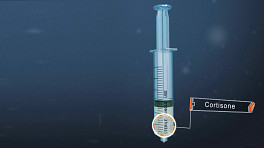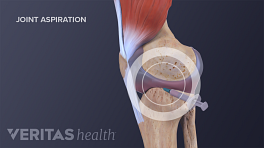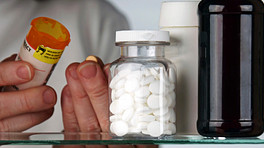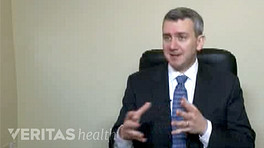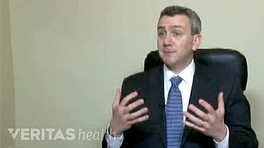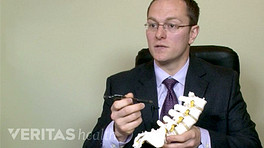Inflammatory joint pain may be relieved with a cortisone injection administered in a doctor's office. The procedure involves several steps and typically takes less than 5 minutes. It may be mildly to moderately painful.
During the procedure, ultrasound or another imaging technology may be used. Whether or not imaging technology is used depends on the:
- Doctor's preference
- Patient's anatomy
- Joint being injected
Imaging technology should be used for all joint injections. Imaging technology must be used for all spinal and sacroiliac injections to avoid injury to vertebral discs or nerve roots and to make sure the targeted joint is in fact injected.
Read more about Injections for Neck and Back Pain on Spine-health.com
In This Article:
Local Anesthetic
The injected cortisone is often mixed with a local anesthetic, so the injected area may feel numb immediately after the procedure. The anesthetic usually wears off within a few hours, at which time the patient may notice an increase in joint pain. This pain is usually gone within 24 hours but can last up to 3 days.
Evidence suggests many local anesthetics may cause cartilage damage. 1 Martin SD, Conaway WK, Lei P. Use of Intra-Articular Corticosteroids in Orthopaedics. J Bone Joint Surg Am. 2018 May 16;100(10):885-891. doi: 10.2106/JBJS.17.00289. PubMed PMID: 29762289. , 2 Gulihar A, Robati S, Twaij H, Salih A, Taylor GJ. Articular cartilage and local anaesthetic: A systematic review of the current literature. J Orthop. 2015;12(Suppl 2):S200–S210. Published 2015 Oct 31. doi:10.1016/j.jor.2015.10.005 For this reason, only certain anesthetics should be considered for intra-articular joint injections. 3 Schwantes J, Byerly DW. Biceps Tendon Sheath Injection. [Updated 2020 Feb 11]. In: StatPearls [Internet]. Treasure Island (FL): StatPearls Publishing; 2020 Jan-. Available from: https://www.ncbi.nlm.nih.gov/books/NBK554412/
Cortisone Injection Step-by-Step
Below is a step-by-step description of a typical cortisone injection procedure. An injection may be administered so that medication is delivered directly into the joint capsule or near the joint capsule, depending on the condition being treated.
- The patient will be asked to sit or lay down in a position that gives the doctor easy access to the joint. For example, if an injection is being administered to the knee, the patient may be told to recline on his or her back with the knee either straight or bent at a 20° or 30° angle with a rolled-up towel to support it.
- The injection site will be cleaned with a disinfectant, such as alcohol or iodine.
- The patient will be encouraged to relax. Relaxing the joint's muscles will make the injection process easier and more comfortable.
- If ultrasound is being used, a gel will be applied to a small area of skin near the injection site, and a technician will gently press a hand-held ultrasound transducer against the gel-covered skin. An image of the joint space will be projected on a screen for the doctor to see.
- The doctor may administer a topical anesthetic to numb the area receiving the injection.
- If the affected joint or bursa contains excess fluid, the doctor may draw out this fluid with a needle and syringe. This procedure is known as joint aspiration or arthrocentesis.
- The doctor will inject a small amount of cortisone into the targeted area. The cortisone may be mixed with an anesthetic, such as lidocaine or bupivacaine. The patient may notice a pinching or burning sensation. The needle is removed.
- The injection area is cleaned and bandaged.
- The patient may be asked to flex and straighten the joint several times to help spread the cortisone.
The patient may be asked to stay in the medical office or waiting room for observation for 30 minutes following the injection. This precaution is taken to make sure that the patient does not have unusually severe pain or an allergic reaction to any material in the injection. It can also provide the physician an opportunity to re-examine the injected joint to see if the pain was relieved by the anesthetic, thus confirming the source of pain.
- 1 Martin SD, Conaway WK, Lei P. Use of Intra-Articular Corticosteroids in Orthopaedics. J Bone Joint Surg Am. 2018 May 16;100(10):885-891. doi: 10.2106/JBJS.17.00289. PubMed PMID: 29762289.
- 2 Gulihar A, Robati S, Twaij H, Salih A, Taylor GJ. Articular cartilage and local anaesthetic: A systematic review of the current literature. J Orthop. 2015;12(Suppl 2):S200–S210. Published 2015 Oct 31. doi:10.1016/j.jor.2015.10.005
- 3 Schwantes J, Byerly DW. Biceps Tendon Sheath Injection. [Updated 2020 Feb 11]. In: StatPearls [Internet]. Treasure Island (FL): StatPearls Publishing; 2020 Jan-. Available from: https://www.ncbi.nlm.nih.gov/books/NBK554412/


